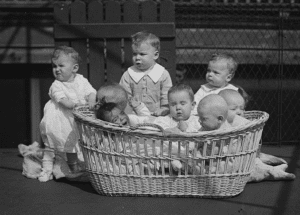Howard Fischer
Uppsala, Sweden
 |
| Babies in a basket. Photo by Harris & Ewing, May 1923. Library of Congress. No known restrictions on publication. |
“It’s up to you to create a generation of soldiers and pioneers for the defense of the empire.”
– Benito Mussolini, to the women of Italy1
“Women are a charming pastime…but they should never be taken seriously,
for they themselves are rarely serious.”
– Benito Mussolini2
Nazi Germany, Francoist Spain, and fascist Italy needed and encouraged the birth of babies. The Nazis arranged conceptions by “pure” Aryan couples. When too few babies were produced, they kidnapped blue-eyed, blond children from Poland. The Francoists wanted Spanish babies brought up by parents with correct political beliefs, so they kidnapped newborns from mothers with suspect loyalties and sold them to “better” parents. In Italy, government and church policies combined with tradition to restrict the role of women to “baby factories” and little else.
In 1925, three years after coming to power in Italy, the fascist government of Benito Mussolini began its attempt to increase the Italian population. The National Organization for the Protection of Maternity and Infancy (ONMI) took control of the 5700 different institutions that cared for women and children. Pregnant women were provided with free food and instructed in hygiene and infant feeding, including financial incentives to breastfeed.3,4 Another goal of ONMI was to make women understand that the primary role of the fascist woman was to produce children.5 In 1926, birth control devices and abortion were outlawed as “crimes against the race.”6 Sex education became illegal and the age of consent and the age for marriage were lowered.7 Mussolini wanted the 1927 Italian population of forty million increased to sixty million by 1950.8 In reality, the 1940 population was 47.5 million.9
Repayment of marital loans was reduced by 10% of the principal for each child a couple had. Married men with more than six children paid no taxes. Bachelors between the age 25 and 65 paid increased taxes.10 The Italian civil service only employed parents. The state-owned railroad dismissed female employees (since they should be at home producing and caring for babies), and later, private industry did the same.11
In 1925, women were given the right to vote in local elections. In 1926, local elections were abolished.12 Women were given two months of paid maternity leave beginning in 1934, and factories employing more than fifty women had to have designated rooms where mothers could nurse their infants.13 In 1939, women who had five children got a medal from the state. A bow was added to the ribbon on the medal for each subsequent child.14 These decorations did not help to feed or clothe large families.
The Catholic attitude to children born out-of-wedlock was nearly impossible to overcome in Italy, as compared with Nazi Germany. The fascists eliminated the possibility of unmarried women anonymously turning in newborns to convents or orphanages.15 This was a good change, since Italian orphanages farmed out “illegitimate” babies to ignorant and disreputable wet nurses who ran so-called “foundling homes.” Over one-half of infants sent to foundling homes died.16 With ONMI, single mothers did not have to register as paupers and better still, the mothers were supported in keeping and caring for their babies.
Of course, the idea of “racial purity” entered fascist law: Italians were not to marry people of African descent. Later, non-Aryans (i.e., Jews) were added to the list.17
Fascist anti-feminism did not produce the desired results. The birth rate (number of live births per 1000 population) was 147 per 1000 in 1911, and 112 per 1000 in 1936.18
The infant mortality rate (deaths per 1000 live births) was 106 per 1000 in 1938, higher than it had been in 1930. For comparison, the infant mortality rate in Holland in 1938 was 36 per 1000.19 Between 1927–1937, the Italian infant mortality rate varied between 5–18%, depending on the region examined. It was 18% in Sicily.20
Maternal mortality was 27 per 10,000 in 1940-1945, but was 24 per 10,000 in 1914.21 The rate of out-of-wedlock births was 5 per 100 in 1924 and was unchanged in 1932. The rate of voluntary abortion trebled to 15% of pregnancies between 1927–1937.22
To conclude with Hite and Hinton: “Fascist anti-feminism was not particularly successful.”23 And as a Turin working-class mother stated: “Mussolini’s not the one to raise it.”24
References
- NA. WW2 Italian fascist mothers medal. National Army Museum, ND. armymuseum.co.nz
- John Hite and Chris Hinton. “Did Mussolini succeed in imposing fascist values on women?” In Fascist Italy, London: John Murray, 2015. cpb-us-e1.wpmucdn.com
- Lella Gondini and Carolyn Edward, eds. Bambini: The Italian Approach to Infant/Toddler Care, New York: Teachers College Press, 2001.
- Maria Quine. “From Malthus to Mussolini: The Italian eugenics movement and fascist population policy, 1890-1938.” UCL-Discovery. Doctoral Thesis University of London, 1990.
- Battle for Births. Wikipedia.
- Stefania Costa and Anne Noon-Luminari. “Forced motherhood in Italy.” Frontiers: A J ofWomen Studies, 2(1), 1977.
- Jennifer Monti. “The contrasting image of Italian women under fascism in the 1930s.” Syracuse University Honors Program Capstone Projects.714. 2011.
- “Battle for Births.”
- Hite. “Did Mussolini.”
- Monti. “Contrasting.”
- “Battle for Births.”
- Hite. “Did Mussolini.”
- NA. “Mothers and families in fascist Italy,” Historical View, ND. webpage.pace.edu
- “WW2 Italian fascists.”
- Monti. “Contrasting.”
- Quine. “Malthus.”
- Monti. “Contrasting.”
- “Battle for Births.”
- Monti. “Contrasting.”
- Quine. “Malthus.”
- Quine. “Malthus.”
- Quine. “Malthus.”
- Hite. “Did Mussolini.”
- Hite. “Did Mussolini.”
HOWARD FISCHER, M.D., was a professor of pediatrics at Wayne State University School of Medicine, Detroit, Michigan.
Spring 2022 | Sections | History Essays

Leave a Reply